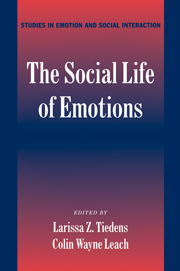Book contents
- Frontmatter
- Contents
- Acknowledgements
- List of Contributors
- The Social Life of Emotions
- Introduction: A World of Emotion
- PART I THE INTERPERSONAL CONTEXT
- PART II THE INTRAGROUP CONTEXT
- PART III THE INTERGROUP CONTEXT
- 11 Intergroup Emotions
- 12 Intergroup Contact and the Central Role of Affect in Intergroup Prejudice
- 13 Judgments of Deserving and the Emotional Consequences of Stigmatization
- 14 Group-based Emotions and Intergroup Behavior
- 15 Interpreting the Ingroup's Negative Actions Toward Another Group
- 16 Intergroup Schadenfreude
- Index
- References
12 - Intergroup Contact and the Central Role of Affect in Intergroup Prejudice
Published online by Cambridge University Press: 01 April 2011
- Frontmatter
- Contents
- Acknowledgements
- List of Contributors
- The Social Life of Emotions
- Introduction: A World of Emotion
- PART I THE INTERPERSONAL CONTEXT
- PART II THE INTRAGROUP CONTEXT
- PART III THE INTERGROUP CONTEXT
- 11 Intergroup Emotions
- 12 Intergroup Contact and the Central Role of Affect in Intergroup Prejudice
- 13 Judgments of Deserving and the Emotional Consequences of Stigmatization
- 14 Group-based Emotions and Intergroup Behavior
- 15 Interpreting the Ingroup's Negative Actions Toward Another Group
- 16 Intergroup Schadenfreude
- Index
- References
Summary
Decades of research have studied the role of intergroup contact in reducing intergroup prejudice (see Allport, 1954; Hewstone & Brown, 1986; Pettigrew & Tropp, 2000, 2003), yet little consensus has emerged regarding its effects. Past reviews of this extensive literature have reached sharply conflicting conclusions. Some indicate that intergroup contact leads to positive changes in intergroup prejudice, especially when the contact occurs under optimal conditions (e.g., Jackson, 1993; Pettigrew, 1971, 1998; Riordan, 1978). Others take a more critical stance. They hold that intergroup contact has relatively little or no effect on broad-scale changes in intergroup prejudice (e.g., Amir, 1976; Ford, 1986; Rothbart & John, 1985).
At first blush, these perspectives appear to be fundamentally inconsistent, reflecting the long-standing debates that have engulfed this research literature during the last half century. We believe this divergence in perspectives has grown out of an overemphasis on the general question of whether intergroup contact will reduce prejudice, with the phenomenon of intergroup prejudice construed as a single dimension. Close examination of the research contributing to these perspectives suggests that many different components of intergroup prejudice – including both affective and cognitive components – must be considered as potential outcomes of intergroup contact. Thus, it may be that different branches of the research literature have emphasized different aspects of the intergroup relationship. We pursue this possibility in this chapter, and we propose that affective dimensions of intergroup relationships are especially important for understanding the effects of contact on intergroup attitudes.
- Type
- Chapter
- Information
- The Social Life of Emotions , pp. 246 - 269Publisher: Cambridge University PressPrint publication year: 2004
References
- 14
- Cited by

